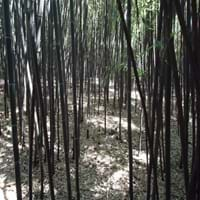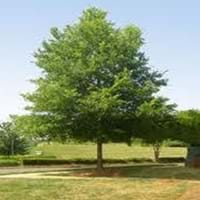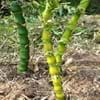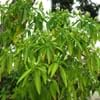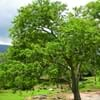Life Span
Perennial
Perennial
Origin
Southeastern Asia
North America, United States, Northeastern United States, Mid-Atlantic United States, Southeastern United States, Central United States, South-Central United States, Texas
Types
Clumping bamboo, Running bamboo, Umbrella bamboo
Not Available
Number of Varieties
Not Available
Habitat
Subtropical climates, Tropical regions
Hot climate regions, low mountains, Tropical regions
USDA Hardiness Zone
9-15
6-9
Sunset Zone
H1, H2, 18, 19, 20, 21, 22, 23, 24
2a, 2b, 3a, 3b, 4, 6, 7, 8, 9, 10, 11, 12, 13, 14, 15, 16, 18, 19, 20, 21
Habit
Clump-Forming
Oval or Rounded
Minimum Width
Not Available
Flower Color
Yellow green
Red, Light Green, Chartreuse
Flower Color Modifier
Bicolor
Bicolor
Fruit Color
Non Fruiting Plant
Tan, Chocolate
Leaf Color in Spring
Green
Green, Light Green
Leaf Color in Summer
Light Green
Green, Dark Green
Leaf Color in Fall
Green
Yellow, Orange, Sandy Brown
Leaf Color in Winter
Green
Not Available
Leaf Shape
Lance shaped
Irregular
Plant Season
Spring, Summer, Fall, Winter
Spring, Fall
Sunlight
Full Sun, Partial Sun
Full Sun, Partial Sun
Growth Rate
Very Fast
Fast
Type of Soil
Loam, Sand
Clay, Loam, Sand
The pH of Soil
Acidic, Neutral, Alkaline
Acidic, Neutral, Alkaline
Soil Drainage
Average
Average
Bloom Time
Not Available
Spring, Late Spring
Tolerances
Cold climate, Drought, Salt
Wet Site, Pollution, Soil Compaction
Where to Plant?
Ground
Ground
How to Plant?
Stem Planting
Grafting, Seedlings
Plant Maintenance
Medium
Low
Watering Requirements
Requires regular watering, Water more in summer
Allow to dry out slightly between watering, Does not require lot of watering
In Summer
Lots of watering
Lots of watering
In Spring
Moderate
Moderate
In Winter
Average Water
Average Water
Soil pH
Acidic, Neutral, Alkaline
Acidic, Neutral, Alkaline
Soil Type
Loam, Sand
Clay, Loam, Sand
Soil Drainage Capacity
Average
Average
Sun Exposure
Full Sun, Partial Sun
Full Sun, Partial Sun
Pruning
No need to prune, Remove damaged leaves, Remove dead branches, Remove dead leaves
cut main flower spike, Prune every year, Remove damaged leaves, Remove dead branches, Remove dead leaves
Fertilizers
All-Purpose Liquid Fertilizer
All-Purpose Liquid Fertilizer, Bonemeal, fertilize in growing season
Pests and Diseases
Aphids, Insects, Red blotch
Azalea leaf gall, Fusarium leaf spot, Leaf rust, Mildew
Plant Tolerance
Cold climate, Drought, Salt
Heat Tolerance, Humidity, Salt and Soil Compaction
Flowers
None
Insignificant
Flower Petal Number
Single
Not Available
Foliage Texture
Fine
Fine
Foliage Sheen
Matte
Glossy
Attracts
Aphids, Insects
Birds
Allergy
no allergic reactions
Eczema, Rhinitis, Runny nose
Aesthetic Uses
Beautification, Showy Purposes
Landscape Designing, Showy Purposes
Beauty Benefits
No Beauty Benefits
Blood purifying, Reduce Bruises, Weightloss
Edible Uses
Yes
Sometimes
Environmental Uses
Air purification
Air purification
Medicinal Uses
No Medicinal Use
Gout, Obesity, Snoring
Part of Plant Used
Stem, Tree trunks
Bark, Stem
Other Uses
Air freshner, Decoration Purposes
Animal Feed, Biodiesel, Recovering internal injuries
Used As Indoor Plant
Yes
No
Used As Outdoor Plant
Yes
Yes
Garden Design
Feature Plant, Tropical
Shade Trees, Street Trees
Botanical Name
BAMBUSA lako
QUERCUS phellos
Common Name
Black Timber Bamboo, Clumping Bamboo, Timor Black Bamboo
Willow Oak
In Hindi
तिमोर काला बांस
Overcup ओक
In German
Timor-schwarzer Bambus
Overcup Oak
In French
Timor bambou noir
Overcup Oak
In Spanish
Timor Negro de bambú
Overcup Roble
In Greek
Τιμόρ Μαύρο μπαμπού
Overcup Oak
In Portuguese
Timor Black Bamboo
Overcup Oak
In Polish
Timor Czarny Bambus
Overcup Dąb
In Latin
Timor Niger Bamboo
Oryza
Phylum
Magnoliophyta
Not Available
Class
Liliopsida
Magnoliopsida
Clade
Angiosperms, Commelinids, Monocots
Angiosperms, Eudicots, Rosids
Tribe
Poaceae
Not Available
Subfamily
Barnadesioideae
Amaryllidoideae
Number of Species
Not Available
Importance of Timor Black Bamboo and Willow Oak
Want to have the most appropriate plant for your garden? You might want to know the importance of Timor Black Bamboo and Willow Oak. Basically, these two plants vary in many aspects. Compare Timor Black Bamboo and Willow Oak as they differ in many characteristics such as their life, care, benefits, facts, etc. Every gardener must at least have the slightest clue about the plants he wants to plant in his garden. Compare their benefits, which differ in many ways like facts and uses. The medicinal use of Timor Black Bamboo is No Medicinal Use whereas of Willow Oak is Gout, Obesity and Snoring. Timor Black Bamboo has beauty benefits as follows: No Beauty Benefits while Willow Oak has beauty benefits as follows: No Beauty Benefits.
Compare Facts of Timor Black Bamboo vs Willow Oak
How to choose the best garden plant for your garden depending upon its facts? Here garden plant comparison will help you to solve this query. Compare the facts of Timor Black Bamboo vs Willow Oak and know which one to choose. As garden plants have benefits and other uses, allergy is also a major drawback of plants for some people. Allergic reactions of Timor Black Bamboo are no allergic reactions whereas of Willow Oak have Eczema, Rhinitis and Runny nose respectively. Having a fruit bearing plant in your garden can be a plus point of your garden. Timor Black Bamboo has no showy fruits and Willow Oak has showy fruits. Also Timor Black Bamboo is not flowering and Willow Oak is not flowering . You can compare Timor Black Bamboo and Willow Oak facts and facts of other plants too.
